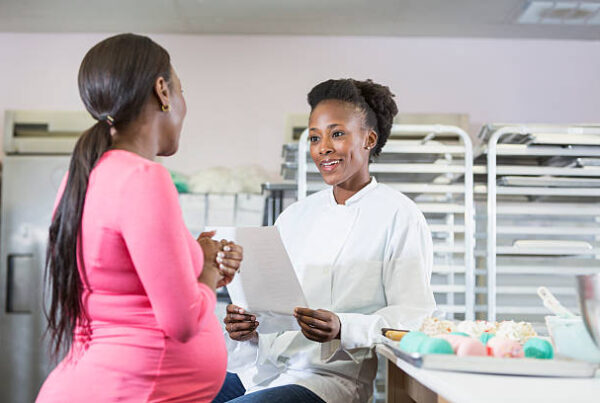For you as a woman, the dream of holding your arms begins long before your first pregnancy test or fertility appointment. But when uterine fibroids—a condition affecting up to 70 percent of women by age 50—step into the picture, that path you are treading to parenthood can suddenly feel tangled in uncertainty.
The story of Maryam Ojo comes into sharp focus, Married for five years, at 38, Maryam is vibrant and healthy, has a good job and loving husband, however she is full of cautious optimism about her fertility. It’s been so ever since she went through two heartbreaking IVF cycles that ended almost before they began. Her embryos just couldn’t find a place to land. A large fibroid turned out to be the challenge. After a hysteroscopic surgery to gently remove the fibroid, Maryam returned for another IVF cycle and this time, it worked. Her story isn’t unusual, but it is extraordinary—because every successful pregnancy after fibroids and IVF is a testament to persistence to healing, and to the power of science paired with good medical care.
There are stories of other women like Maryam who’ve walked the same road and now share their stories in forums and in patient groups. They tell stories of heartbreak, grit, and finally, joy. There is the story of Ayo, who battled a 5 cm intramural fibroid removal and two IVF cycles to welcome her baby girl. There is also Sade and Kunle – the couple who found a clinic that treated fibroid care as part of fertility—not a separate problem, but one piece of a whole. For any woman that is exploring IVF, fibroids can introduce hurdles that feel both physical and deeply emotional. However, with careful support and thoughtful care, there’s every reason why you should believe and hope.
Fibroids, those benign but often frustrating growths in or around the uterus, come in all shapes and sizes. For some women, they’re little more than a medical footnote, for others, they loom large—impacting periods, pelvic comfort, and most poignantly, fertility. Where fibroids grow makes a difference. If you have heard of submucosal fibroids, they are the ones that grow in the inner lining of uterine cavity, and are the most likely to interfere with developing embryo. For intramural fibroids, these ones sit in the muscular wall, and can disrupt the natural shape and function of your uterus. Subserosal fibroids grow on the outer edges, often staying silent unless they become large enough to physically interfere with your welfare.
When fibroids distort the space where an embryo should implant or interfere with blood flow and hormones, even the most advanced fertility treatments like IVF can stumble. If you are having fibroids, particularly the submucosal ones, your chances of IVF success can be reduced by as much as half, but this doesn’t mean the journey stops there.
The first step toward a plan that works is clear diagnosis. That means using tools like transvaginal ultrasounds, hysteroscopy, and in some cases MRI—to see what can’t be felt and uncover what’s quietly working against your information that scans can offer. And sometimes, just knowing—finally having an answer—offers unexpected relief in a process that often feels like guesswork. If your fibroids are small and not disturbing the delicate balance of the uterus, careful monitoring may be enough. You may benefit from medications that temporarily shrink the fibroids before surgery or treatment, but if you’re hoping to preserve your uterus—and your chance to conceive, a minimally invasive or non-invasive procedure is the way to go to restore hope by removing the growths. Addressing fibroids this way can help improve IVF success rates.
Timing matters, too. After fibroid removal, it’s generally best to let the uterus recover and strengthen. The waiting is a wait with purpose—a small pause for a safer journey ahead. IVF protocols can and should adapt to your needs if you’re with fibroids. You might be recommended to freeze your embryos until after fibroid treatment, giving your uterus time to heal before transfer. There are medications to prepare the endometrial lining and ultrasound-guided embryo transfers also help maximize success. With treatment, women under 35 with previously problematic fibroids had IVF birth rates nearly equal to women with fibroid-free uteruses. Still, there’s more to this journey than what shows up in a chart. There are the quiet tears after disappointing cycles, the strain of financial planning for costly treatments and surgeries, and the ache of wanting something so deeply it colors every part of your life.
This is where support from therapists, forums, or just one understanding friend can make all the difference. The transparency from clinics and honest conversations with the specialists and doctors about options also count. Timing, and the very human need to feel seen are part of the equation.
There’s empowerment, too, in what you can do for yourself. Embracing a balanced diet rich in calming, anti-inflammatory foods, staying physically active, and finding pockets of peace in meditation, prayer, or yoga can help support not just the body, but the spirit. Regular checkups and a proactive mindset go a long way in staying ahead of fibroid growth. Every step count, even the quiet ones.
The journey of fibroid and IVF is not an obstacle course, but a pathway, one that may have extra turns, maybe a few steep climbs—but also moments of light, connection, and the steady rhythm of moving forward. With the right medical team, personalized care, and the quiet courage to keep going, fibroids don’t have to stand in your way of building a family.





